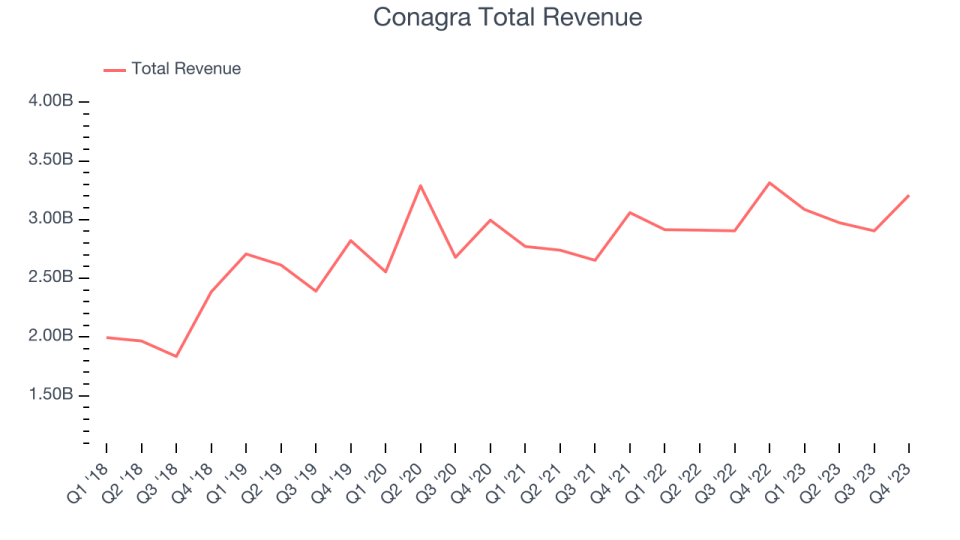Conagra (NYSE:CAG) Misses Q2 Sales Targets

Packaged foods company Conagra Brands (NYSE:CAG) fell short of analysts' expectations in Q2 FY2024, with revenue down 3.2% year on year to $3.21 billion. It made a non-GAAP profit of $0.71 per share, down from its profit of $0.81 per share in the same quarter last year.
Key Takeaways from Conagra's Q2 Results
This was an underwhelming quarter. Organic revenue growth was down and missed expectations, leading to a revenue miss. EPS beat, but the company lowered its full year outlook for EPS. Overall, the results could have been better. The company is down 2.6% on the results and currently trades at $28.5 per share.
Is now the time to buy Conagra? Find out by accessing our full research report, it's free.
Conagra (CAG) Q2 FY2024 Highlights:
Market Capitalization: $13.99 billion
Revenue: $3.21 billion vs analyst estimates of $3.23 billion (0.8% miss)
EPS (non-GAAP): $0.71 vs analyst estimates of $0.68 (4.6% beat)
Free Cash Flow of $340.7 million, up 13.6% from the previous quarter
Gross Margin (GAAP): 26.4%, down from 27.8% in the same quarter last year
Organic Revenue was down 3.4% year on year (miss vs. expectations of down 2.1% year on year)
Sales Volumes were down 2.9% year on year
Founded in 1919 as Nebraska Consolidated Mills in Omaha, Nebraska, Conagra Brands today (NYSE:CAG) boasts a diverse portfolio of packaged foods brands that includes everything from whipped cream to jarred pickles to frozen meals.
Packaged Food
As America industrialized and moved away from an agricultural economy, people faced more demands on their time. Packaged foods emerged as a solution offering convenience to the evolving American family, whether it be canned goods, prepared meals, or snacks. Today, Americans seek brands that are high in quality, reliable, and reasonably priced. Furthermore, there's a growing emphasis on health-conscious and sustainable food options. Packaged food stocks are considered resilient investments. People always need to eat, so these companies can enjoy consistent demand as long as they stay on top of changing consumer preferences. The industry spans from multinational corporations to smaller specialized firms and is subject to food safety and labeling regulations.
Sales Growth
Conagra is one of the larger consumer staples companies and benefits from a well-known brand, giving it customer mindshare and influence over purchasing decisions.
As you can see below, the company's annualized revenue growth rate of 1.9% over the last three years was weak as consumers bought less of its products. We'll explore what this means in the "Volume Growth" section.

This quarter, Conagra missed Wall Street's estimates and reported a rather uninspiring 3.2% year-on-year revenue decline, generating $3.21 billion in revenue. Looking ahead, Wall Street expects sales to grow 1.4% over the next 12 months, an acceleration from this quarter.
While most things went back to how they were before the pandemic, a few consumer habits fundamentally changed. One founder-led company is benefiting massively from this shift and is set to beat the market for years to come. The business has grown astonishingly fast, with 40%+ free cash flow margins, and its fundamentals are undoubtedly best-in-class. Still, its total addressable market is so big that the company has room to grow many times in size. You can find it on our platform for free.
Volume Growth
Revenue growth can be broken down into changes in price and volume (the number of units sold). While both are important, volume is the lifeblood of a successful staples business as there’s a ceiling to what consumers will pay for everyday goods; they can always trade down to non-branded products if the branded versions are too expensive.
To analyze whether Conagra generated its growth from changes in price or volume, we can compare its volume growth to its organic revenue growth, which excludes non-fundamental impacts on company financials like mergers and currency fluctuations.
Over the last two years, Conagra's average quarterly sales volumes have shrunk by 1.9%. This decrease isn't ideal as the quantity demanded for consumer staples products is typically stable. Luckily, Conagra was able to offset fewer customers purchasing its products by charging higher prices, enabling it to generate 4.5% average organic revenue growth. We hope the company can grow its volumes soon, however, as consistent price increases (on top of inflation) aren't sustainable over the long term unless the business is really really special.

In Conagra's Q2 2024, sales volumes dropped 2.9% year on year. This result was a step in the right direction compared to its 8.4% year-on-year decline 12 months ago.
Conagra may not have had the best quarter, but does that create an opportunity to invest right now? When making that decision, it's important to consider its valuation, business qualities, as well as what has happened in the latest quarter. We cover that in our actionable full research report which you can read here, it's free.
One way to find opportunities in the market is to watch for generational shifts in the economy. Almost every company is slowly finding itself becoming a technology company and facing cybersecurity risks and as a result, the demand for cloud-native cybersecurity is skyrocketing. This company is leading a massive technological shift in the industry and with revenue growth of 50% year on year and best-in-class SaaS metrics it should definitely be on your radar.
Join Paid Stock Investor Research
Help us make StockStory more helpful to investors like yourself. Join our paid user research session and receive a $50 Amazon gift card for your opinions. Sign up here.
